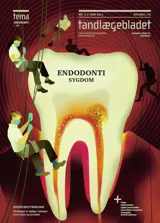Inflammation og hårdtvævsdannelse i pulpa
I forbindelse med et cariesangreb ses ofte hårdtvævsdannelse i pulpa. Hårdtvævsdannelsen eller tertiær dentin er et respons på både ekstern nedbrydning af dentinen samt inflammation i pulpa. Der ses ikke altid tertiær dentin i forbindelse med et cariesangreb, da den tertiære dentindannelse hænger sammen med cariesangrebets aktivitet. Cellestudier har antydet, at inflammation kan virke både hæmmende og fremmende for tertiær dentin, men den bagvedliggende dynamik er ikke fuldstændigt kortlagt. For at kunne bedømme, om det er muligt at bevare pulpa-vitalitet i forbindelse med behandlingen af profund caries, skal tandlægen forsøge at vurdere, hvorvidt der er tale om en reversibel eller irreversibel inflammations¬proces. Da der ikke findes én sikker indikator for korrekt diagnostik, er det nødvendigt både at inddrage patientens symptombillede og at vurdere cariesangrebets aktivitet i den diagnostiske proces.
Inflammation and hard tissue formation in the dental pulp: Hard tissue formation in the dental pulp is a commonly seen phenomenon in relation to the carious process. This can be regarded as a response to carious destruction of the dental hard tissues, as well as an inflammatory process in the dental pulp. In some cases hard tissue formation is not seen in conjunction with the carious process, and the absence of increased reactive/reparative hard tissue has been shown to be related to the activity of the carious process. Cell culture studies have implied that inflammation can have both inhibiting as well as an activating effect on hard tissue formation, but the underlying dynamics have not been fully elucidated. Clinically, a great improvement in preserving pulp-vitality when treating deep caries, would be for the dentist to be able to predict whether the inflammatory process of the dental pulp, in a given case, is reversible or irreversible. As no such indicator is currently known, it is of paramount importance that the symptoms of the patient as well as the carious process proper, be drawn into the diagnostic process.


